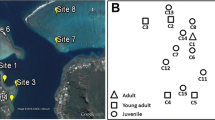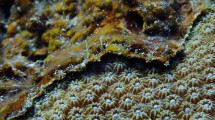Abstract
With increasing exposure to local and global stressors associated with a rapidly changing climate, corals adapted to thrive within stressful environments are of particular interest to researchers and managers. A bleaching resilient Porites coral with an unusual appearance was discovered dominating shallow waters (1–2 m) within Honolulu Harbor, Hawai‘i, a heavily sedimented and polluted habitat with high levels of anthropogenic influence. Continuous monitoring of this ‘Harbor Porites’ revealed prolific year-round brooding and release of planula larvae, with no clear seasonal pattern. Furthermore, recruitment and rapid growth were observed in seawater tanks followed by fusing of various sized colonies, indicating brooding of clonal larvae. Genetic markers placed this coral with high similarity (histone and ITS sequences are 99.9% and 99.4% similar, respectively) to corals in the P. lobata species complex which are gonochoric broadcast spawning corals. Fixed differences were observed, and FST values were high and significant, which could either be explained by reproductive isolation or from clonal sampling over a limited area (this coral has not yet been found in other locations). Observations of skeletal microstructure also showed similarity to corals in the P. lobata complex, although with a higher proportion of corallites with excavated columella resulting in a cavity similar in size to the brooded larvae. These observations suggest that bleaching resilience and reproductive mode may be more plastic than previously assumed for Porites corals. Additional work is needed to determine if these corals represent a very recent endemic species, an introduced coral, the result of reproductive disruption from pollution (e.g., endocrine disruption), or extreme phenotypic variation within the P. lobata complex. Prolific growth and production of larvae, combined with observations of resilience to anthropogenic impacts such as bleaching, sedimentation, and pollution, make this coral a good candidate model for the study of adaptation and acclimatization to climate change and other anthropogenic stressors.





Similar content being viewed by others
References
AECOS, Inc. (2014) Water Quality and Biological Surveys (HM, 2007, Appendix E), 37 and surveys in 2012 by Marine Research Consultants, Inc., entitled Assessment of the Marine Biological Draft Environmental Assessment—Honolulu Harbor Piers 24–29 Subdivision 5–21 1 Community Structure in the Vicinity of the Proposed Kapalama Container Terminal, Honolulu, Hawai‘i, 2 which was completed in conjunction with an EIS prepared for the Kapālama Container Terminal and 3 Tenant Relocations project (DOT-H, 2014, Appendix E).http://oeqc.doh.hawaii.gov/Shared%20Documents/EA_and_EIS_Online_Library/Oahu/2010s/2013-01-23-DEA-5B-Honolulu-Harbor-Pier-12-15-Improvements.pdf
Andrews S, Sutherland RA (2004) Cu, Pb and Zn contamination in Nuuanu watershed, Oahu, Hawaii. Science of the Total Environment 324(1–3):173–182
Abecia JED, Guest JR, Villanueva RD (2016) Geographical variation in reproductive biology is obscured by the species problem: a new record of brooding in Porites cylindrica, or misidentification? Invertebr Biol 135:58–67
Ayre DJ, Resing JM (1986) Sexual and asexual production of planulae in reef corals. Mar Biol 90:187–190
Barshis DJ, Stillman JH, Gates RD, Toonen RJ, Smith LW, Birkeland C (2010) Protein expression and genetic structure of the coral Porites lobata in an environmentally extreme Samoan back reef: does host genotype limit phenotypic plasticity?, 19(8):1705–1720. http://doi.org/10.1111/j.1365-294X.2010.04574.x
Bell G (2017) Evolutionary rescue. Annual Review of Ecology, Evolution and Systematics 48:605–627
Bessell-Browne P, Fisher R, Duckworth A, Jones R (2017) Mucous sheet production in Porites: an effective bioindicator of sediment related pressures. Ecological Indicators 77:276–285. https://doi.org/10.1016/j.ecolind.2017.02.023
Coles SL, Bolick H, Hauk B, Montgomery A (2009) Ten year resurveys of the biodiversity of marine communities and introduced species in Pearl Harbor, Honolulu Harbor, and Ke‘ehi Lagoon, O‘ahu, Hawai‘i. Bishop Museum Technical Report No. 48, June 2009
Excoffier L, Lischer HEL (2010) Arlequin suite ver 3.5: a new series of programs to perform population genetics analyses under Linux and Windows. Molecular Ecology Resources 10:564–567. https://doi.org/10.1111/j.1755-0998.2010.02847.x
Fabricius KE (2005) Effects of terrestrial runoff on the ecology of corals and coral reefs: review and synthesis. Marine Pollution Bulletin 50(2):125–146. https://doi.org/10.1016/j.marpolbul.2004.11.028
Fenner D (2005) Corals of Hawaii. Mutual Publishing, Honolulu
Flot JF (2010) SeqPHASE: a web tool for interconverting PHASE input/output files and FASTA sequence alignments. Molecular Ecology Resources 10:162–166. https://doi.org/10.1111/j.1755-0998.2009.02732.x
Forsman ZH, Barshis DJ, Hunter CL, Toonen RJ (2009) Shape-shifting corals: molecular markers show morphology is evolutionarily plastic in Porites. BMC Evolutionary Biology 9:45
Forsman ZH, Martinez JA, Maragos JE, Toonen RJ (2010) Zootaxa, Resurrection of Porites hawaiiensis Vaughan, 1907; a Hawaiian coral obscured by small size, cryptic habitat, and confused taxonomy. Zootaxa 2624:67–68
Forsman ZH, Wellington GM, Fox GE, Toonen RJ (2015) Clues to unraveling the coral species problem: distinguishing species from geographic variation in Porites across the Pacific with molecular markers and microskeletal traits. PeerJ 3(68):e751. https://doi.org/10.7717/peerj.751
Forsman ZH, Knapp ISS, Tisthammer KH, Eaton DAR, Belcaid M, Toonen RJ (2017) Coral hybridization or polymorphism? Genomic data reveal gene flow between Porites lobata and P. compressa. Molecular Phylogenetics and Evolution 111:132–148
Franklin EC, Jokiel PL, Donahue MJ (2013) Predictive modeling of coral distribution and abundance in the Hawaiian Islands. Marine Ecology Progress Series 481:121–132
Gilmour J (1999) Experimental investigation into the effects of suspended sediment on fertilisation, larval survival and settlement in a scleractinian coral. Marine Biology 135(3):451–462
Golbuu Y, Gouezo M, Kurihara H, Rehm L, Wolanski E (2016) Long-term isolation and local adaptation in Palau’s Nikko Bay help corals thrive in acidic waters. Coral Reefs 1–11
Guindon S, Delsuc F, Dufayard J-F, Gascuel O (2009) Estimating maximum likelihood phylogenies with PhyML. Methods Mol Biol 537:113–137
Hughes TP (2003) Climate change, human impacts, and the resilience of coral reefs. Science 301(5635):929–933. https://doi.org/10.1126/science.1085046
Humanes A, Ricardo GF, Willis BL, Fabricius KE, Negri AP (2017) Cumulative effects of suspended sediments, organic nutrients and temperature stress on early life history stages of the coral Acropora tenuis. Nature Publishing Group, Berlin. https://doi.org/10.1038/srep44101
Kumar S, Stecher G, Tamura K (2016) MEGA7: molecular evolutionary genetics analysis version 7.0 for bigger datasets. Molecular Biology and Evolution 33:1870–1874
Laws EA, Ziemann D, Schulman D (1999) Coastal water quality in Hawaii: the importance of buffer zones and dilution. Marine Environmental Research 48(1):1–21. https://doi.org/10.1016/S0141-1136(99)00029-X
Levas SJ, Grottoli AG, Hughes A, Osburn CL, Matsui Y (2013) Physiological and biogeochemical traits of bleaching and recovery in the mounding species of coral Porites lobata: implications for resilience in mounding corals. PLoS ONE 8(5):e15–e63. https://doi.org/10.1371/journal.pone.0063267
Loh PC, Fujioka RS, Lau LS (1979) Recovery, survival and dissemination of human enteric viruses in ocean waters receiving sewage in Hawaii. Water, Air, and Soil Pollution 12(2):197–217
McMurtry GM, Wiltshire JC, Kauahikaua JP (1995) Heavy metal anomalies in coastal sediments of Oahu, Hawaii. Pac Sci 49(4):452–470
Miller MA, Karazsia J, Groves CE, Griffin S, Moore T, Wilber P, Gregg K (2016) Detecting sedimentation impacts to coral reefs resulting from dredging the Port of Miami, Florida USA. PeerJ 4:e2711. https://doi.org/10.7717/peerj.2711
National Academies of Sciences, Engineering, and Medicine (2019) A decision framework for interventions to increase the persistence and resilience of coral reefs. Committee on interventions to increase the resilience of coral reefs. National Academies Press, Washington DC. https://doi.org/10.17226/25424
Nosil P (2007) Divergent host plant adaptation and reproductive isolation between ecotypes of Timema cristinae walking sticks. Am Nat 169:S151–S162
Omori M, Fukami H, Kobinata H, Hatta M (2001) Significant drop of fertilization of Acropora corals in 1999: an after-effect of heavy coral bleaching? Limnol Oceanogr 46(3):704–706. https://doi.org/10.4319/lo.2001.46.3.0704
Perez K III, Rodgers KS, Jokiel PL, Lager CV, Lager DJ (2014) Effects of terrigenous sediment on settlement and survival of the reef coral Pocillopora damicornis. PeerJ 2(3):e387. https://doi.org/10.7717/peerj.387
Palumbi SR, Barshis DJ, Traylor-Knowles N, Bay RA (2014) Mechanisms of reef coral resistance to future climate change. Science 344:895–898
Richmond RH, Hunter CL (1990) Reproduction and recruitment of corals: comparisons among the Caribbean, the Tropical Pacific, and the Red Sea. Marine Ecology Progress Series 60:185–203
Ronquist F, Teslenko M, van der Mark P, Ayres DL, Darling A, Höhna S, Larget B, Liu L, Suchard MA, Huelsenbeck JP (2012) MrBayes 3.2: efficient Bayesian phylogenetic inference and model choice across a large model space. Syst Biol 61:539–542
Seligman PF, Grovhoug JG, Valkirs AO, Stang PM, Fransham R, Stallard MO, Davidson B, Lee RF (1989) Distribution and fate of tributyltin in the united states marine environment. Appl Organomet Chem 3:31–47. https://doi.org/10.1002/aoc.590030104
Serrano X, Baums I, Smith T et al (2016) Long distance dispersal and vertical gene flow in the Caribbean brooding coral Porites astreoides. Sci Rep 6:21619. https://doi.org/10.1038/srep21619
Smith LW, Barshis D, Birkeland C (2007) Phenotypic plasticity for skeletal growth, density and calcification of Porites lobata in response to habitat type. Coral Reefs 26(3):559–567. https://doi.org/10.1007/s00338-007-0216-z
Stephens M, Smith NJ, Donnelly P (2001) A new statistical method for haplotype reconstruction from population data. American journal of human genetics 68:978–989. https://doi.org/10.1086/319501
Stoddart JA (1983) Asexual production of planulae in the coral Pocillopora damicornis. Mar Biol 76:279–284
Swain TD, Bold EC, Osborn PC, Baird AH, Westneat MW, Backman V, Marcelino LA (2018) Physiological integration of coral colonies is correlated with bleaching resistance. Mar Ecol Prog Ser 586:1–10. https://doi.org/10.3354/meps12445
Tisthammer KH, Forsman ZH, Toonen RJ, Richmond RH (2020) Genetic structure is stronger across human-impacted habitats than among islands in the coral Porites lobata. PeerJ 8:e8550. https://doi.org/10.7717/peerj.8550
Vaughan TW (1907) Recent Madreporaria of the Hawaiian Islands and Laysan. Bull United States Nat Museum. https://doi.org/10.5479/si.03629236.59.i
Veron JEN (2000) Corals of the world. Australian Institute of Marine Science, Townsville
Vollmer SV, Palumbi SR. 2002. Hybridization and the evolution of reef coral diversity. Science 296:20232025. https://doi.org/10.1126/science.1069524
Wang W-X, Yang Y, Guo X, He M, Guo F, Ke C (2011) Copper and zinc contamination in oysters: subcellular distribution and detoxification. Environ Toxicol Chem 30(8):1767–1774. https://doi.org/10.1002/etc.571
Acknowledgements
Authors wish to thank Dr. Doug Fenner for his skeletal analysis, Dr. James WA Murphy for his diving expertise, Kalei Nu‘uhiwa for nomenclature assistance, and the staff at the DAR coral facility on Sand Island, Norton Chan, Chelsea Wolke, David Gulko, and Brian Neilson. The authors wish to acknowledge The Kohala Center, Kamehameha Schools, Dr. Paul and Elizabeth Nakayama and the Deviants from the Norm Fund for providing funding for NPS. Colony collection was made possible under Hawai‘i Division of Aquatic Resources SAP 2016-66 and SAP 2018-17. This is HIMB contribution #1791 and SOEST #10931. The findings and conclusions in this article are those of the authors and do not necessarily represent the views of the U.S. Fish and Wildlife Service.
Author information
Authors and Affiliations
Corresponding author
Ethics declarations
Conflict of interest
On behalf of all authors, the corresponding author states that there is no conflict of interest.
Additional information
Publisher's Note
Springer Nature remains neutral with regard to jurisdictional claims in published maps and institutional affiliations.
Electronic supplementary material
Below is the link to the electronic supplementary material.
Rights and permissions
About this article
Cite this article
Brown, N.P., Forsman, Z.H., Tisthammer, K.T. et al. A resilient brooding coral in the broadcast spawning Porites lobata species complex: a new endemic, introduced species, mutant, or new adaptive potential?. Coral Reefs 39, 809–818 (2020). https://doi.org/10.1007/s00338-020-01922-w
Received:
Accepted:
Published:
Issue Date:
DOI: https://doi.org/10.1007/s00338-020-01922-w




